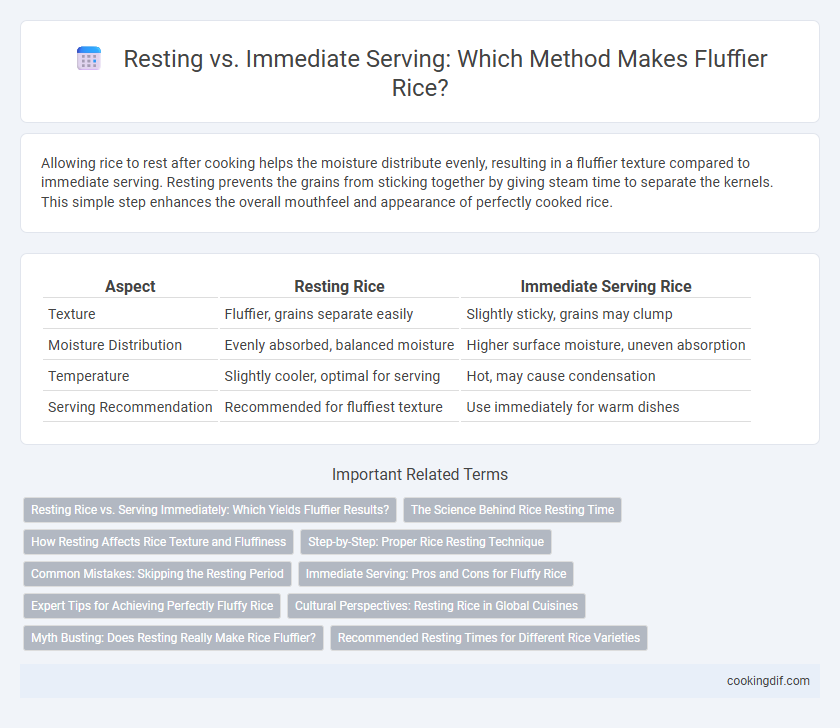Allowing rice to rest after cooking helps the moisture distribute evenly, resulting in a fluffier texture compared to immediate serving. Resting prevents the grains from sticking together by giving steam time to separate the kernels. This simple step enhances the overall mouthfeel and appearance of perfectly cooked rice.
Table of Comparison
| Aspect | Resting Rice | Immediate Serving Rice |
|---|---|---|
| Texture | Fluffier, grains separate easily | Slightly sticky, grains may clump |
| Moisture Distribution | Evenly absorbed, balanced moisture | Higher surface moisture, uneven absorption |
| Temperature | Slightly cooler, optimal for serving | Hot, may cause condensation |
| Serving Recommendation | Recommended for fluffiest texture | Use immediately for warm dishes |
Resting Rice vs. Serving Immediately: Which Yields Fluffier Results?
Resting rice after cooking allows excess moisture to evaporate evenly, resulting in fluffier, separate grains compared to serving immediately. This process enhances texture by letting steam gently finish cooking the rice, preventing clumping and mushiness. Optimal resting time ranges from 5 to 10 minutes before fluffing with a fork to maximize airiness and softness.
The Science Behind Rice Resting Time
Rice fluffiness improves significantly when allowed to rest after cooking, as the residual steam evenly redistributes moisture within the grains. During resting, the starches absorb water fully, preventing clumping and resulting in a lighter texture. Immediate serving often leads to sticky rice due to insufficient moisture equilibration and heat distribution.
How Resting Affects Rice Texture and Fluffiness
Resting rice after cooking allows steam to evenly redistribute moisture within the grains, resulting in a fluffier and less sticky texture. This process helps separate the grains by allowing excess moisture to evaporate, preventing clumping and enhancing the overall mouthfeel. Immediate serving tightly packs the grains with moisture, often yielding a denser, more compact texture compared to rested rice.
Step-by-Step: Proper Rice Resting Technique
Allow cooked rice to rest covered for 10-15 minutes to steam evenly and enhance fluffiness by redistributing moisture. Use a clean kitchen towel or lid to trap steam, preventing condensation from making the rice soggy. Gently fluff the rice with a fork after resting to separate grains and improve texture before serving.
Common Mistakes: Skipping the Resting Period
Skipping the resting period after cooking rice often leads to dense, sticky grains rather than fluffy, separate ones. Allowing rice to rest for 10-15 minutes lets moisture redistribute evenly, improving texture and flavor. Immediate serving without this crucial step traps steam, resulting in clumped rice that lacks the desired lightness.
Immediate Serving: Pros and Cons for Fluffy Rice
Immediate serving of rice preserves heat and moisture, enhancing the rice's natural fluffiness and preventing it from becoming sticky or clumpy. This method is ideal for dishes requiring hot, soft grains and saves time, especially in fast-paced cooking environments. However, serving rice immediately may result in slightly less evenly cooked grains compared to resting, as the starches haven't fully set and separated.
Expert Tips for Achieving Perfectly Fluffy Rice
Allowing rice to rest covered for 10-15 minutes after cooking enables steam redistribution, resulting in evenly fluffy grains. Fluffing immediately with a fork before resting can cause breaking and clumping, reducing texture quality. Expert chefs recommend resting as a crucial step to achieve light, separate, and perfectly fluffy rice every time.
Cultural Perspectives: Resting Rice in Global Cuisines
Resting rice after cooking enhances its texture by allowing moisture to redistribute, resulting in fluffier grains, a practice embraced in many global cuisines such as Japanese and Indian. In Japanese culture, resting rice is essential to achieve the desired sticky yet airy consistency for sushi, while in Indian cuisine, resting basmati rice helps preserve the individual grain integrity for biryani. Contrastingly, some Southeast Asian cultures prefer immediate serving to retain warmth and slight stickiness, showcasing the diverse cultural perspectives on rice preparation.
Myth Busting: Does Resting Really Make Rice Fluffier?
Resting rice after cooking allows steam to redistribute moisture evenly, preventing clumping and resulting in fluffier grains. Immediate serving often causes rice to be sticky or dense due to trapped steam and uneven moisture levels. Scientific tests confirm that a 5-10 minute resting period significantly improves texture by reducing excess surface moisture and promoting separate, fluffy grains.
Recommended Resting Times for Different Rice Varieties
Optimal rice fluffiness depends on specific resting times after cooking; for basmati rice, a 10-minute resting period allows moisture redistribution, resulting in well-separated grains, while jasmine rice benefits from a shorter 5-minute rest to maintain its natural stickiness. Short-grain rice varieties, such as sushi rice, require minimal resting, around 3 minutes, to preserve their characteristic stickiness and texture. Adjusting resting times according to rice type enhances texture and flavor, ensuring perfectly cooked rice every time.
Resting vs Immediate serving for fluffiness Infographic

 cookingdif.com
cookingdif.com